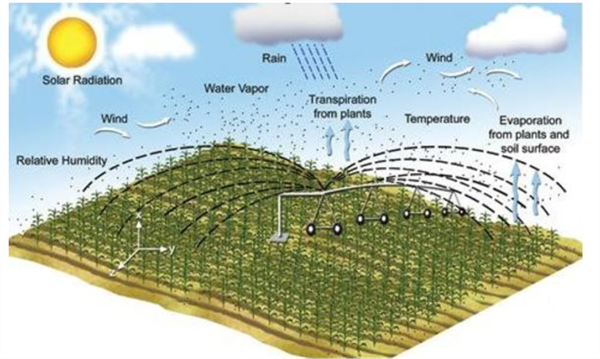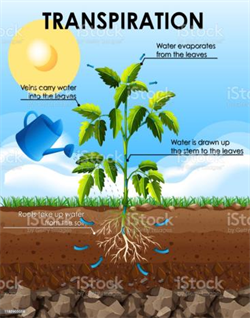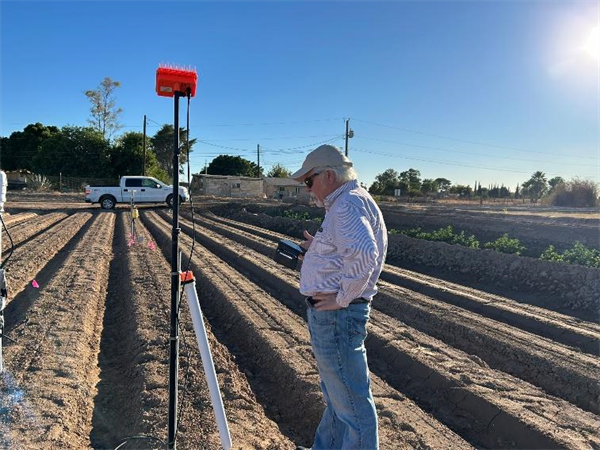
For those interested in in-row weed control, checkout the quality video below (Fig. 1) on how finger weeders (Fig. 2) are being used on a 3,600 acre organic cotton farm in Texas. The grower states that finger weeders help him achieve 95-97% weed control and are a highly cost-effective tool for lowering hand weeding costs.
Fig. 1. Carl Pepper discusses how finger weeders are used to control in-row weeds on
his 3,600 acre organic cotton farm. Click here or on image to view. (Photo credit: Tilmor
LLC, Dalton, OH)

Fig. 2. Finger weeders, an in-row weeding tool, operating in seedling cotton. Finger
weeder pairs are centered on the seed row and overlapped slightly to loosen soil in the
row and uproot small weeds.
Biological control is an important IPM tool globally. This pest suppression technique is especially important for managing pests in organic crop production. There are various biological control techniques, including conservation biological control, classical biological control, and augmentative biological control. Conservation biological control is the practice of providing habitat to support abundant populations of naturally occurring arthropods that attack crop pests. However, classical biological control and augmentative biological control involve the release of arthropod predators and parasitoids, usually non-native, into the field or greenhouses. This article focuses on conservation biological control.
The contribution of native beneficial insects to pest control has been estimated to be approximately $4.5 billion annually in the United States alone. However, the benefits of beneficial insects areoften overlooked. Research conducted across the country has shown evidence that conserving natural habitats leads to an increase in beneficial arthropod populations and a reduction in pest problems on farms. Beneficial arthropod predators and parasitoids often rely on natural or semi-natural areas adjacent to the field for their persistence. Between growing seasons, these natural and semi-natural areas provide alternative food sources, overwintering, and nesting habitats for natural enemies, thereby promoting their populations. To complete their life cycle, natural enemies require more than just prey or hosts; they also need refuge sites and alternative food sources.
Neighboring natural and semi-natural habitats serve as sources of natural enemies during the growing seasons to suppress crop pests. The establishment of wildflower margins around crop fields increases the abundance of beneficial insects that search for pollen and nectar. For example, many adult parasitoids sustain themselves with pollen and nectar from nearby flowering plants while searching for hosts. Most natural enemies do not disperse far from their overwintering sites; access to permanent habitat near or within the field gives them a jump-start on early pest populations.
Farms with diverse and dense populations of natural enemies are likely to exhibit the following characteristics:
- Have small fields surrounded by natural vegetation.
- Composed of diversified cropping systems and plant populations in or around fields include perennials and flowering plants.
- Crops are managed organically or with minimal agrichemicals.
- Soils are high in organic matter and biological activity and, during the off-season, covered with mulch or vegetation.

Figure 1. Syrphid fly feeding from sweet alyssum flowers.

Figure 2. Mix flowers planted on strips between rows of celery to provide food and
shelter for natural enemies.
The combination of two separate processes whereby water is lost on the one hand from the soil surface by evaporation and on the other hand from the crop by transpiration, is referred to as evapotranspiration (ET). Evaporation is the process whereby liquid water is converted to water vapor (vaporization) and removed from the evaporating surface (vapor removal). Water evaporates from a variety of surfaces, such as lakes, rivers, pavements, soils, and wet vegetation. Energy is required to change the state of the molecules of water from liquid to vapor. Direct solar radiation and, to a lesser extent, the ambient temperature of the air provide this energy (Fig:1).

Figure 1: Key factors driving ET in agriculture include solar radiation, temperature, wind,
humidity, and plant and soil water loss.
Transpiration consists of the vaporization of liquid water contained in plant tissues and the vapor removal to the atmosphere. Crops predominantly lose their water through stomata. These are small openings on the plant leaf through which gases and water vapor pass. The water, together with some nutrients, is taken up by the roots and transported through the plant (Fig: 2).

Figure 2: A diagram illustrates the process of transpiration in plants, where water is
absorbed by roots, moves through the stem, and evaporates from the leaf surfaces.
Why evapotranspiration (ET)?
ET is the largest component of the hydrological cycle and is one of the most critical variables in irrigation management, crop production, and the sustainability of agriculture. It has a direct impact on water resources availability and use, water quality, and the earth’s energy balance. Daily evapotranspiration (ET) rates are needed for irrigation scheduling. The evapotranspiration rate is normally expressed in millimeters (mm) or inches (in) per unit of time (e.g., an hour, day, week, month, or even an entire growing period or year).
Reducing evapotranspiration (ET) can lead to significant water savings by minimizing unnecessary water loss through soil evaporation and plant transpiration. By applying irrigation more efficiently only when and where it's needed, plants can maintain optimal moisture levels, reducing stress and promoting better growth. This can enhance nutrient uptake, improve plant health, and ultimately lead to higher yields. Moreover, conserving water through reduced ET is especially critical in arid regions, where freshwater resources are limited, and efficient water use is essential for sustainable agricultural production.
Below are strategies to reduce ET

Figure 3: Figure 3. Soil moisture sensor installation at the Valley Research Center,
Yuma, AZ.